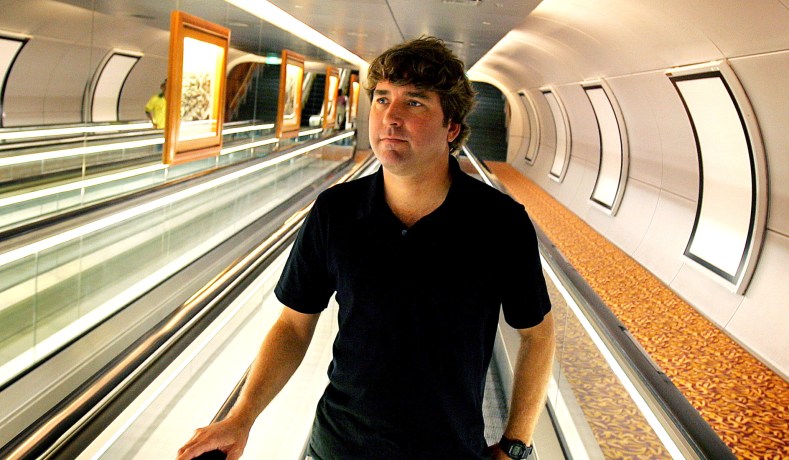Stephen Hillenburg’s SpongeBob universe captivated Americans of all ages.
It would be nice if more Americans recognized the name of Stephen Hillenburg, who passed away this week, but it is the destiny of some lives to be eclipsed by their creations. A cheerful anthropomorphic sea sponge, in this case.
The inaugural episode of SpongeBob SquarePants aired on the Nickelodeon network on Saturday morning, May 1, 1999. Nearly two decades later, the titular character and his undersea pals have risen to become some of the most ubiquitous figures of American pop culture. It’s barely worth reciting an obligatory list of places where SpongeBob’s gap-toothed grin can be found. Just go to Walmart; I’m sure he’ll turn up.
Hillenburg gave us a world of absurdist sea creatures that were as imaginative as they were hilarious. They bubbled life from every gill and pore, each bearing a sharp and distinctive personality that synced perfectly with their beautifully economical visual design. It was a cartoonist’s cartoon, a work of pure madcap silliness that did everything an animated series could possibly aspire to.
Creating memorable, lovable, versatile characters is a complex and difficult art. It requires a sophisticated understanding of how people relate to one another and what mix of personality traits we find compelling, not to mention a skill for stories and settings capable of deploying these traits in interesting ways. In a capitalist economy, character craftsmanship is among the most competitive battlegrounds in the entertainment industry.
It is also a field where Americans excel. The 57-year-old Hillenburg, who suffered from Lou Gehrig’s disease, may have had his creative output cut shorter than that of superhero magnate Stan Lee, who passed away a few weeks ago at age 95. But in terms of creative genius, the men were compatriots of a great national tradition. In many ways, Hillenburg’s truncated life most closely parallels that of Jim Henson, the brilliant mind behind the Muppets whose death from a freak bacterial infection at age 53 left his many fans feeling similarly robbed.
That said, as one of the country’s great cartooning minds, Hillenburg produced work that was less overtly American than Mickey Mouse, Peanuts, The Simpsons, or even Garfield, whose studious cultural neutrality only enhances its global marketability. Explicitly, at least, SpongeBob said little about American life. Its characters were cartoons in the truest sense of the term — nonhuman creatures who lived in a fully realized, imaginary world of places and people that formed an independent culture unto themselves. Thematically, SpongeBob SquarePants was closer to Pixar franchises like Cars or Monsters Inc., or recent Disney works such as Zootopia or Wreck-It Ralph, in that it gleefully eschewed realism in favor of a more fantastical alternative.
Yet subtle American flourishes abounded just the same. The “nautical kitsch” aesthetic of SpongeBob’s world — bamboo beds with lifesaver pillows, porthole windows on tiki-head houses, an omnipresent backdrop of stylized Day-Glo flowers — owed much to America’s midcentury obsession with all things Polynesian and tropical. This fad, in turn, may’ve come from a fascination many young American soldiers developed during tours of the Pacific theater in WWII, as well as from the post-war rise of the new state of Hawaii as the country’s preeminent domestic vacation hotspot.
SpongeBob’s frantically slaphappy personality, likewise, was an obvious pastiche of American comic greats. Hillenburg often cited Jerry Lewis and Paul Reubens as specific inspiration, as well as older slapstick giants, including Laurel and Hardy. As is often the case with cartoons about talking animals, SpongeBob’s fictional life was rife with ridiculous pantomimes of American middle-class living — the drudgery of fast-food jobs, long-suffering neighbors, even crazed fandom for Stan Lee–esque superheroes. The show’s ability to captivate an entire generation of Americans — children and adults alike — is a testament to the familiarity of its themes, even when disguised with seaweed and barnacles.
SpongeBob SquarePants, to be sure, is not an unqualified masterpiece. No parent of young children will be able to muster much praise for the show’s open embrace of obnoxiousness. And even hardcore fans will admit that many episodes fail to achieve the promised blend of absurd and fun, and are simply grating — or even unsettling. Now airing its twelfth season, the show has faced charges of becoming a soulless “zombie franchise,” as many now accuse The Simpsons of being. It was a sentiment sometimes shared by Hillenburg himself, who came to resent his creation’s excessive commercialization. On several occasions, he attempted to walk away, only to be pulled back in to assert control when it became obvious his universe was going to continue with or without him.
Yet such are the demons that inevitably haunt any successful entertainment franchise in the modern United States. Managing the legacy of a blockbuster work of fiction after it transcends its original medium and becomes a free-floating “brand” is itself a uniquely American occupation, and one that few artists perform perfectly.
Hillenburg’s cartoon universe, like the worlds of Disney, Schultz, Henson, and Lee, has now been fully absorbed by the national culture. No longer the supervised children of a living father, his characters have become the property of strangers. Let’s hope we treat them with the respect they’ve earned.

